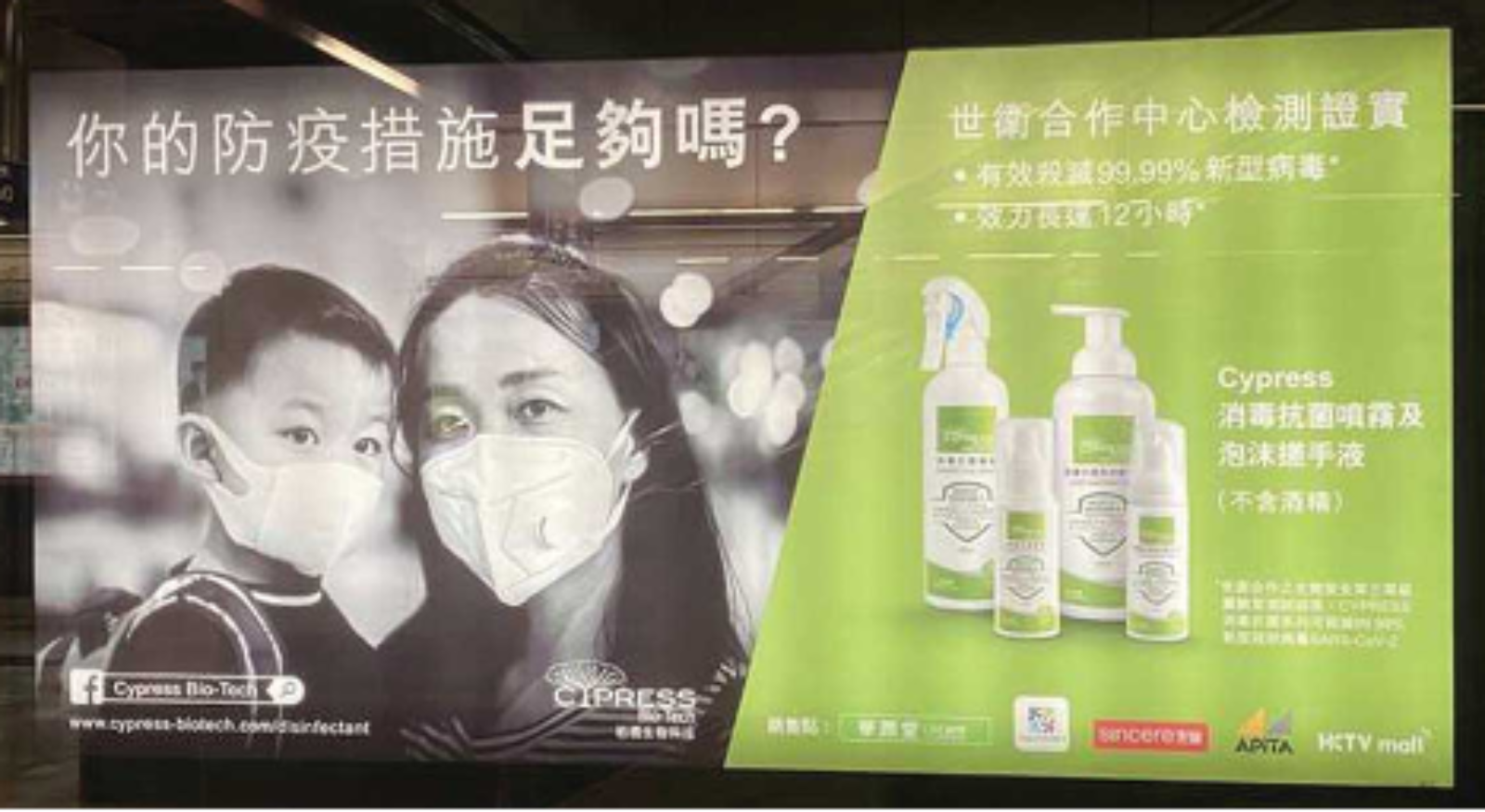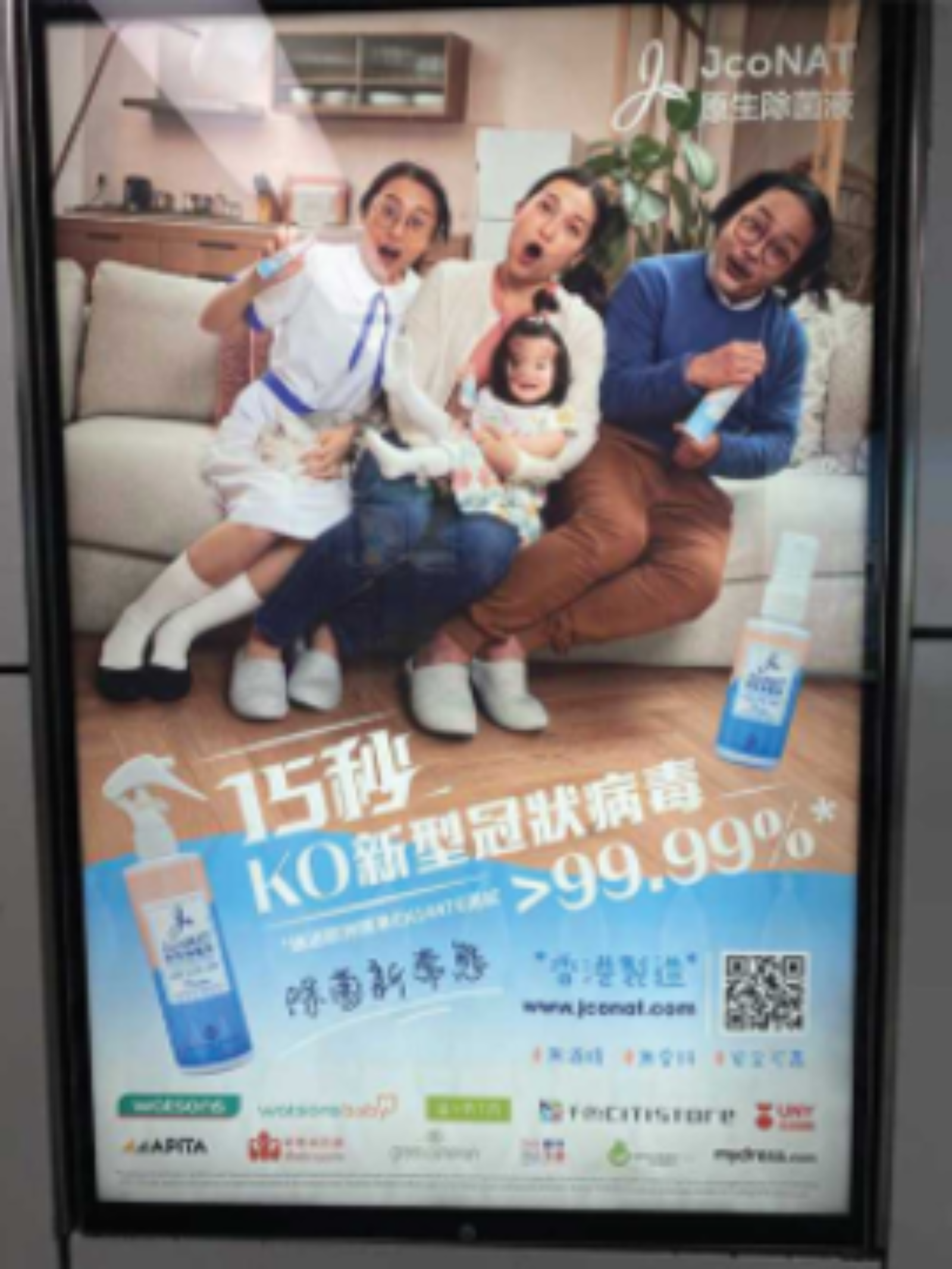Critical discourse scholar Vincent Wai Sum Tse, transcultural discourse scholar Jasper Zhao Zhen Wu, and sociolinguistics scholar Andre Joseph Zheng analyze how advertising in Hong Kong during the pandemic influenced consumer behavior through messages of risk and protection in their academic article, “‘Money Can Buy Health’ Risk and Protection in Hong Kong’s COVID-19 Advertisement-scape.” They employ the technique of multimodal critical discourse analysis to billboard advertisements of health supplements, personal protective equipment (PPE), and disinfectants in Mass Transit Railway (MTR) stations, a major mode of transport in Hong Kong, to investigate the significance of visual elements and slogans in the advertisements in achieving emotive and promotional functions. The authors argue that such advertisements embed the notion of “responsibilisation of health,” or assign the responsibility of staying healthy to the viewer, thus making it the viewer’s responsibility to choose the right products to improve their health and protect themselves from disease. The prevalence of these advertisements throughout the city during the pandemic created an “affective regime,” a set of visual and spatial cues “governing the experience and expectation of affects (emotional and attitudinal reactions to people or situations) within any sites” (Wee, qtd. in Tse, Wu, and Theng 261).
A key implication of such advertisements is that one’s surroundings are dangerous amid the pandemic. By extension, they imply that protecting one’s health is of utmost importance, which incentivizes consumers to buy the products that are marketed to safeguard health and safety. For example, the authors identified monochrome colors and blurred images as key visual features that created a sense of environmental danger in an advertisement for hand sanitizing foam and disinfectant spray. The depiction of characters with apprehensive and tense expressions generates similar feelings in viewers, while a caption, “Are your preventative measures enough?” directly addresses viewers’ existing safety measures and challenges their effectiveness. The product, displayed on a bright green background which is associated with healthiness, is presented as the solution to the anxiety-inducing environmental dangers. It enhances its legitimacy by featuring statistics about the effectiveness and effect duration of products that are supported by “WHO Collaborating Centre tests,” which are authoritative sources on health information. Amid the uncertainty and danger of the pandemic, the product presents itself as a source of trustworthiness and safety to attract consumers. As the number of new COVID-19 cases decreased towards late 2020 and early 2021 and the risks of COVID-19 became normalized, a new promotional message of maintaining the cleanliness and safety of familial environments gained prevalence in health advertising. One such advertisement is for a naturally occurring disinfectant, depicting the product in a domestic setting, and employing humor and exaggeration to draw viewers’ attention instead of generating a sense of danger.
This article dissects the multimodality of advertising for COVID-19 related products, or their combined use of color, photos, manipulation of images, and captions containing emotive statements or scientific information, to create a sense of risk in the environment and promote their products as protection against one’s dangerous surroundings. Additionally, the article shows how advertising for PPE evolved in response to changes in public perception of COVID-19 health risks, from an unfamiliar, omnipresent threat that people could only protect themselves from with sufficient and effective PPE, to the integration of disinfection and the use of PPE into Hong Kong residents’ daily routines and family lives.
 and
and 
Image Captions:
Image 1. Billboard advertisement for hand sanitising foam and disinfectant spray. Via “‘Money Can Buy Health’ Risk and Protection in Hong Kong’s COVID-19 Advertisement-Scape” by Vincent Wai Sum Tse, Jasper Zhao Zhen Wu, and Andre Joseph Theng. Pragmatics and Society, vol. 14, no. 2, Jan. 2023, pp. 257–80.Image 2. Billboard advertisement featuring naturally existing disinfectant. Via “‘Money Can Buy Health’ Risk and Protection in Hong Kong’s COVID-19 Advertisement-Scape” by Vincent Wai Sum Tse, Jasper Zhao Zhen Wu, and Andre Joseph Theng. Pragmatics and Society, vol. 14, no. 2, Jan. 2023, pp. 257–80.
Citation: Tse, Vincent Wai Sum, Jasper Zhao Zhen Wu, and Andre Joseph Theng. “‘Money Can Buy Health’ Risk and Protection in Hong Kong’s COVID-19 Advertisement-Scape.” Pragmatics and Society, vol. 14, no. 2, Jan. 2023, pp. 257–80. EBSCOhost, bit.ly/4nLVfcc. NON-FICTION, SCHOLARLY ARTICLE | CHINA. ll
Source Type: Scholarship on COVID-19 Studies
Country: China
Date: 01-Jan-2023
Keywords: Advertising, Multimodal Critical Discourse Analysis, Personal Protective Equipment, Protection, and Risk